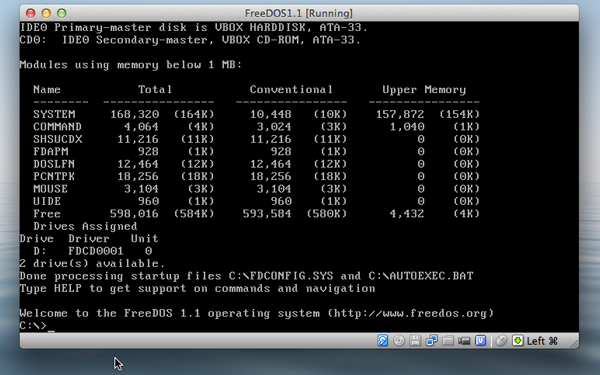
- #MSDOS 6.22 DISK IMAGE CREATOR HOW TO#
- #MSDOS 6.22 DISK IMAGE CREATOR SOFTWARE#
- #MSDOS 6.22 DISK IMAGE CREATOR CODE#
- #MSDOS 6.22 DISK IMAGE CREATOR DOWNLOAD#
Print the partition type using ‘p’ to see the change, and then press ‘w’ to write the changes to the image.
#MSDOS 6.22 DISK IMAGE CREATOR CODE#
Press ‘L’ to find the code to enter for FAT16 (not <= 32M). Next step is to run fdisk on the image itself to create the FAT16 partition: $ fdisk documents.img First, let’s create the actual file itself using ‘dd’: $ dd if=/dev/zero of=documents.img bs=1K count=1440Ī standard 1.44MB floppy image has been created using ‘dd’.

On systems like Ubuntu, you should already have these tools installed. The tools needed are ‘dd’, ‘fdisk’, and ‘mkfs.fat’. The command line will be used to create the images. Ctrl-F4 will then go back to the beginning of the floppy list. To cycle through the loaded images, press Ctrl-F4 to put the next set of floppies into their drives, so “documents.img” goes into A: and “games1.img” into B: Pressing Ctrl-F4 again will put “games1.img” into A: and “games2.img”. DOSBox will treat the DOS 6.22 image as the A: drive and the “documents.img” file as the B: drive. This will boot into MS-DOS 6.22 with the option to cycle through the images. boot “MSDOS622.IMG” “documents.img” “games1.img” “games2.img” -l a Again, it is recommended to put these floppies in the same directory as the boot image just to make it easier down the track, but that is entirely up to you. Multiple FloppiesĭOSBox can take multiple floppy images as parameters for the boot command. Note that “-l a” simply tells “boot” to boot from the A: drive. boot “MSDOS622.IMG” -l a DOSBox should successfully boot the floppy image. Y: Now run the boot command to boot from the image as well as specifying the drive to boot from. Mount Y: /home/unix_allsort/.dosbox/floppies My recommendation is to mount the directory where you intend to keep your floppies first, then navigate to them to reference the floppy image file. Once the floppy image has been obtained, open up the DOSBox config file and scroll to the bottom of the autoexec section to insert some commands that will allow you to easily boot from an image. Look for an MS-DOS 6.22 boot disk as an example.
#MSDOS 6.22 DISK IMAGE CREATOR HOW TO#
This guide will also show you how to load several floppies at once using the “boot” command in DOSBox. To start with, all that is needed is a disk image that will boot into MS-DOS.
#MSDOS 6.22 DISK IMAGE CREATOR DOWNLOAD#
There are places you can visit on the Internet where you can download DOS systems in the form of bootable disk images. This can be simulated by using a floppy image which is simply a file that represents an entire floppy disk drive.
#MSDOS 6.22 DISK IMAGE CREATOR SOFTWARE#
Many floppies contained games or other software that would have automatically booted once the system started (using the autoexec.bat script). Now you can copy your old dos games and other files to /mnt.Continuing on from the previous tutorial, we move on to boot DOS systems from floppy images. $ sudo mount -o loop,offset=32256 msdos622.img /mntĬ dos drvspace.bin io.sys msdos.sys If the image has multiple partitions then the same approach can be used and each partition can be individually mounted on a seperate mount point. To calculate the offset we need to multiply the starting block (63 in our case) by 512. You can do this from the extra functions menu.ġ6 heads, 63 sectors/track, 0 cylinders, total 0 sectors To work this around we need to calculate the offset size of the partition using the fidisk -ul command: In some cases useful info is found in syslog - try Missing codepage or helper program, or other error Mount: wrong fs type, bad option, bad superblock on /dev/loop0, $ sudo mount msdos622.img /mnt -o loop -t msdos Since the image file has a partition table in it, when I tried to mount it, I got the following errors: Now in order to transfer your old games and programs, you need to mount it as loopback device in linux. Next create a directory DOS in C:\ and copy all the utilities into it:ĭOS is ready to be used. The /s option of format command transfers the system to the drive. Once you get the DOS prompt back format the drive C and make it bootable: $ qemu -hda msdos622.img -cdrom DOS6.22_bootdisk.iso -boot dįrom the DOS prompt, create a partition on drive C using fdiskĪfter the partition is created the machine will be rebooted. Oh by the way I damaged my copy of WordStart 4 and Lotus 123 for DOS, if you happen to have one and don’t mind sharing please upload it to a public place and send me a link.Ĭreate a disk image of desired size. Read on to find out how did I manage to set-up a MS-DOS VM using QEMU.

Today’s Virtualization technology had made it possible to run a DOS environment. Using dbase III, in a DOS environment reminds me of some of the great times I used to had in college as a student and later when I started my carrier as a Trainer. Being an old DOS user, sometimes there is an urge to go back to college days and recall how we used to do various things in DOS.


 0 kommentar(er)
0 kommentar(er)
